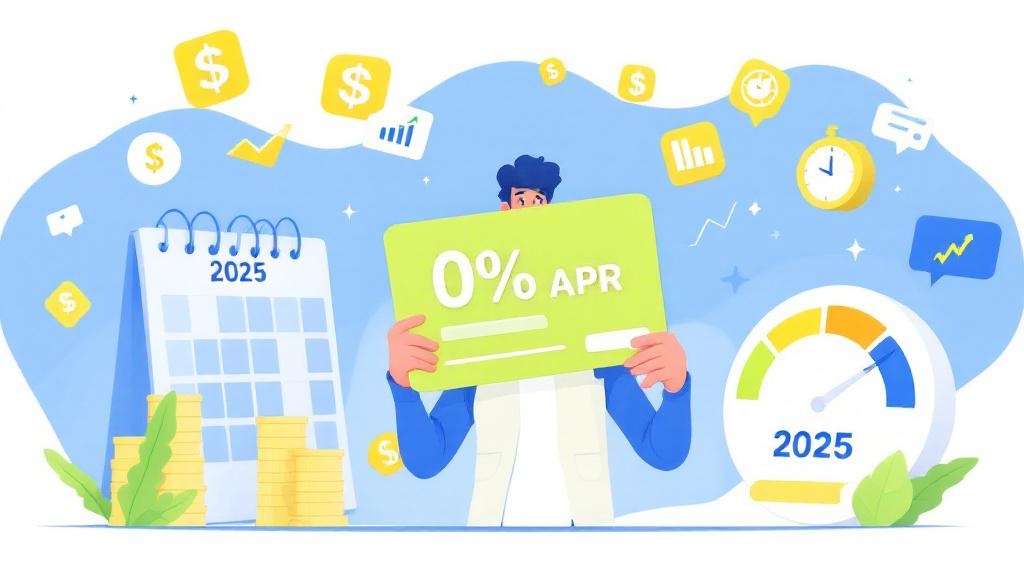If you’ve ever carried a balance on a credit card, you’ve likely felt the sting of interest charges. But what if there were a way to avoid those charges completely—at least for a while? That’s where zero APR credit cards come into play. In this guide, you’ll learn what an APR rate on a credit card is, how it affects your finances, and how to leverage zero APR offers to save money in 2025.
💳 What Is an APR Rate on a Credit Card?
APR, or Annual Percentage Rate, is the yearly interest rate you’re charged when you carry a balance on your credit card. It includes the interest rate and sometimes additional fees, expressed as a percentage.
Let’s say your credit card APR is 20%. If you carry a $1,000 balance for a year, you’ll owe roughly $200 in interest—unless you pay it off earlier.
Types of APRs on Credit Cards
Variable APR Credit Cards: These rates can fluctuate based on the market (usually the prime rate).
Fixed APR Credit Cards: These rates stay the same unless the issuer notifies you of a change (less common).
Introductory APR Offers: Some cards offer 0% APR for an initial period (usually 6 to 21 months).
Cash Advances APR: Higher APRs often apply when you withdraw cash using your credit card.
📉 Why Zero APR Credit Cards Matter in 2025
With interest rates still hovering at relatively high levels in 2025, zero APR cards offer a powerful way to:
Pay off large purchases over time
Consolidate high-interest debt
Avoid growing your credit card balance due to interest
If you’re planning a big expense or trying to escape debt, 0% APR introductory offers can help you save hundreds—or even thousands—on credit card interest rates.
🔍 How Credit Card APR Works
To fully grasp what an APR rate on a credit card means for your wallet, consider how credit card companies apply it.
Daily Interest Calculation
Most issuers calculate interest daily. For example, with a 20% APR:
Daily rate = 20% ÷ 365 = 0.0548%
On a $1,000 balance: 0.0548% × 1,000 = $0.55 per day
Over time, this adds up—especially if you’re only making minimum payments.
When Interest Is Charged
If you pay your balance in full each month: You usually avoid interest.
If you carry a balance: Interest starts accumulating from the purchase date (or end of the grace period).
🧠 APR vs. Interest Rate: What’s the Difference?
A common confusion is APR vs. interest rate. They sound similar, but they’re not identical.
| Term | Meaning |
|---|---|
| Interest Rate | The basic cost of borrowing, before fees |
| APR | The interest rate + any additional lender fees, expressed annually |
Always compare APRs—not just interest rates—when evaluating cards.
🏆 Best Zero APR Credit Cards in 2025
Here are some types of cards offering 0% APR deals that could save you in 2025:
1. Balance Transfer Credit Cards
0% APR for up to 21 months
Great for paying down existing high-interest balances
Look out for balance transfer fees (usually 3–5%)
2. Purchase APR Intro Cards
Ideal for big buys (appliances, medical bills, etc.)
No interest for 12–18 months
Make sure to pay it off before the intro period ends
3. Dual Purpose Cards
Offer 0% APR on both purchases and balance transfers
Best of both worlds—especially if you need flexibility
💡 Real-Life Example: How a 0% APR Card Saves You Money
Imagine you owe $3,000 on a card with a 24% APR. You switch to a 0% APR card for 18 months with a 3% transfer fee ($90).
Without the 0% APR card:
Interest over 18 months: ~$650
Total cost: $3,650
With 0% APR:
Interest: $0
Transfer fee: $90
Total cost: $3,090
👉 You save $560—just by choosing the right credit card.
🧾 What to Watch Out For
Zero APR cards are great, but not risk-free. Here are some important things to consider:
1. Post-Introductory APR
After the 0% period ends, you’ll be subject to a variable or fixed APR—often 17% to 27% in 2025.
2. Credit Score Impact
Applying for a new card creates a hard inquiry on your credit report, which might slightly lower your score short-term.
3. Fees and Penalties
Late payments can trigger penalty APRs—up to 30%—and cancel your promo offer.
4. Credit Utilization
Transferring a large balance can increase your credit utilization, which affects your credit score. Try to keep it under 30%.
🛠 Tips to Use Zero APR Cards Effectively
Pay more than the minimum: Divide the balance by months left in promo period.
Set reminders: Know when the 0% APR ends.
Don’t add new purchases unless they also qualify for 0% APR.
Avoid cash advances: They often come with high APRs and no grace period.
📊 Average APR for Credit Cards in 2025
As of mid-2025, here’s the breakdown:
| Card Type | Average APR |
|---|---|
| Rewards Cards | 20% – 26% |
| Store Cards | 25% – 30% |
| Low APR Credit Cards | 13% – 18% |
| Balance Transfer Cards | 0% (Intro) → 18% – 25% (Regular) |
Choosing a low APR credit card is still a smart move after your 0% APR period ends.
🔚 Conclusion: Is a Zero APR Credit Card Right for You?
Understanding what an APR rate on a credit card means is the first step toward smart borrowing. A zero APR credit card can be your best tool to:
Escape high-interest debt
Make major purchases without added costs
Take control of your finances in 2025
But make sure you have a plan. Use the intro period wisely, pay on time, and don’t let interest sneak up when the promo ends.
🙋 FAQs About APR on Credit Cards
1. What is an APR rate on a credit card and why is it important?
APR stands for Annual Percentage Rate. It represents the yearly interest you’ll pay if you carry a balance. Knowing your APR helps you avoid unnecessary interest charges.
2. Do all credit cards have the same APR?
No. APRs vary based on your credit score, the type of card, and whether it’s a variable or fixed APR credit card.
3. How can I qualify for low APR or 0% APR offers?
A good-to-excellent credit score, steady income, and low existing debt will increase your chances of qualifying for low APR credit cards.
4. What happens when the introductory APR ends?
Once the introductory APR offer ends, your rate will jump to the standard APR—often between 18–27%. Make sure to repay your balance before then.
5. Does APR affect my minimum payment?
Yes. Higher APRs lead to higher minimum payments because more of your payment goes toward interest.
6. Can credit card APR be negotiated?
Sometimes. If you’ve been a loyal customer with good history, your issuer may lower your APR if you ask.
7. What’s the APR on cash advances?
Cash advance APRs are usually much higher—often 25–30%—and start accruing interest immediately with no grace period.








Comments (0)